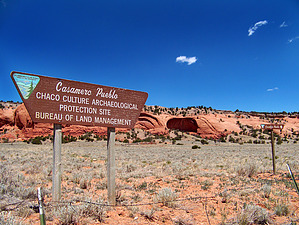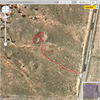| Guide | ♦ | 2 Triplogs | 1 Topic |
details | drive | no permit | forecast | route |
stats |
photos | triplogs | topic | location |
| 30 | 2 | 1 |
Feel like something is watching? by PaleoRob Warning: While this hike is short, there is no water available. It is also located near an active rail line and power plant. Use appropriate caution while in the area.
Hike: The hike starts from the signed parking area. From there you pass through a hiker's maze and then up a straight path to a trail register (as of June 2010, there was nothing inside the register - not even paper. Considering the dates written in pencil on the register lid, this has been the case for several years.) the trail makes a sharp turn, brings you up over the plaza front wall, and to a sign that explains the basics of Casamero, along with an artist's reconstruction of what Casamero looked like when occupied. The trail then heads up into the ruin itself. There are several signs that explain various features of the ruin, and no particular order that they need to be examined in. After looking at the rooms and reading the signs, I recommend walking down the back wall of the Great House - the wall casts no shadow at noon on the solstice. The looming alcoves on the east face of Ojos Tecolote do really resemble a set of giant owl eyes. If you are adventuresome, you can head south to the large depression with a pole sticking out of it - this appears to be the remains of a Great Kiva, based on location, size, and exposed masonry on the south wall. All through the hike you will hear the whine of the Escalante Generating Station, just behind the ridge, as it is producing electricity. A few times a day a train will bring coal in from the coal mine to the northeast, so you may hear that lonesome whistle blow. Except for a few vehicles using County Road 19, the site is quiet. Enjoy your time at Casamero - you will probably be the only visitor that day. Check out the Official Route and Triplogs. Leave No Trace and +Add a Triplog after your hike to support this local community. | ||||||||||||||||||||||||||||||||||||||||||||||||||||||||||||||||||||||||||||||||||||||||||||
 Route Editor
Route Editor





